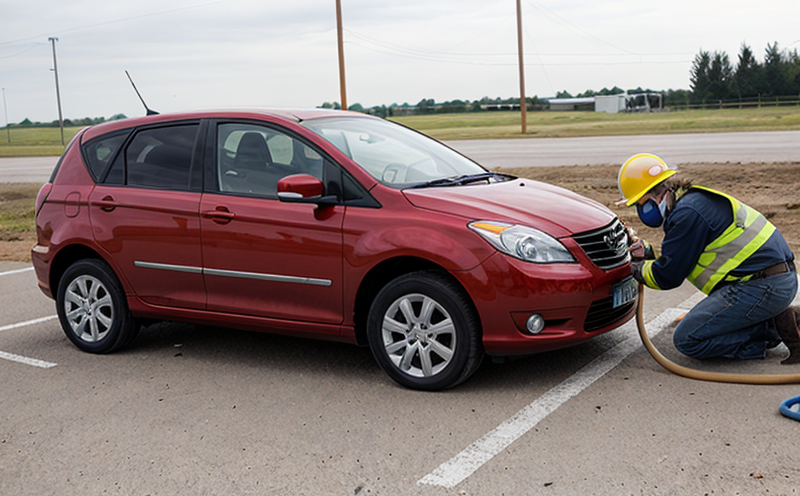SAE J3061 Cybersecurity and Functional Safety Testing for Vehicles
The automotive industry is undergoing a paradigm shift towards smarter and more connected vehicles. As cars become increasingly reliant on software, cybersecurity has emerged as a critical concern. The SAE J3061 standard provides a framework to ensure that advanced automotive systems meet the highest levels of safety and security.
SAE J3061 is particularly important in the context of functional safety testing for vehicles. This standard integrates cybersecurity into traditional safety engineering practices, addressing both the physical safety aspects (ISO 26262) and the cyber dimensions that can impact vehicle performance and driver safety.
The SAE J3061 standard was developed with input from experts in automotive cybersecurity and functional safety. It provides a structured approach to identify potential security vulnerabilities, assess risks, and implement mitigation strategies throughout the entire lifecycle of an automotive system. The standard emphasizes that cybersecurity is not merely an add-on but an integral part of the vehicle's overall design.
SAE J3061 introduces several key concepts:
- Cybersecurity risk analysis: Identifying potential risks and threats to the automotive system.
- Risk mitigation strategies: Implementing measures to reduce identified risks, including software updates, access control, and secure communication protocols.
- Continuous monitoring: Ensuring that systems remain resilient against evolving cybersecurity threats.
The standard is applicable to all types of vehicles, from passenger cars to commercial trucks. It is particularly relevant for electric vehicles (EVs) and autonomous driving technologies, which rely heavily on software and data exchange between components.
Implementing SAE J3061 involves a multi-step process:
- Risk Identification: Identify all potential risks associated with the vehicle's electronic systems. This includes hardware vulnerabilities, software bugs, and external threats.
- Risk Analysis: Evaluate the likelihood and impact of each identified risk. Prioritize risks based on their potential to cause harm or compromise safety.
- Mitigation Strategies: Implement measures to mitigate high-priority risks. This may include software updates, hardware modifications, and procedural changes.
- Continuous Monitoring: Establish ongoing processes for monitoring system performance and identifying new threats.
Scope and Methodology
| Aspect | Description |
|---|---|
| Risk Identification | Identification of all potential risks associated with the vehicle's electronic systems, including hardware vulnerabilities and software bugs. |
| Risk Analysis | Evaluation of the likelihood and impact of each identified risk. Prioritization based on potential to cause harm or compromise safety. |
| Mitigation Strategies | Implementation of measures to mitigate high-priority risks, including software updates, hardware modifications, and procedural changes. |
| Continuous Monitoring | Ongoing processes for monitoring system performance and identifying new threats. |
The SAE J3061 standard is designed to complement existing automotive safety standards such as ISO 26262. By integrating cybersecurity into the functional safety framework, it ensures that both physical and digital aspects of vehicle design are addressed comprehensively.
Implementing SAE J3061 requires a multidisciplinary approach involving engineers from various domains including software development, hardware engineering, and security experts. This ensures that all potential risks are identified and mitigated effectively.
International Acceptance and Recognition
The SAE J3061 standard has gained significant recognition within the automotive industry, with many major manufacturers adopting it as a guiding principle for their cybersecurity initiatives.
SAE J3061 aligns closely with other international standards such as ISO 27001 (Information Security Management System), and is compatible with the broader SAE J1850 suite of documents that address vehicle electrification, connectivity, and cybersecurity. The standard’s recognition by major organizations ensures its relevance and applicability across different geographical regions.
By adhering to SAE J3061, automotive manufacturers can demonstrate their commitment to safety and security, thereby building trust with consumers and regulators alike. This is particularly important in the context of autonomous driving technologies, where public confidence plays a crucial role in market adoption.
Environmental and Sustainability Contributions
The SAE J3061 standard indirectly contributes to environmental sustainability by promoting the development of resilient, secure automotive systems. Secure software is less likely to fail or require frequent updates, reducing the need for premature replacement of electronic components.
- Reduction in Electronic Waste: By ensuring that vehicles remain secure and reliable over their entire lifecycle, the standard helps reduce the amount of electronic waste generated by automotive manufacturers.
- Energy Efficiency: Secure systems are less prone to malfunctions that could lead to inefficiencies. This contributes to overall energy efficiency in both vehicle operation and manufacturing processes.
The standard also promotes responsible use of resources through its emphasis on secure software updates and continuous monitoring, which can help extend the lifecycle of vehicles and components.





